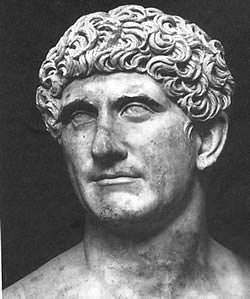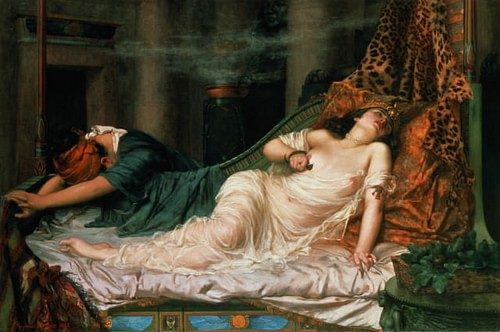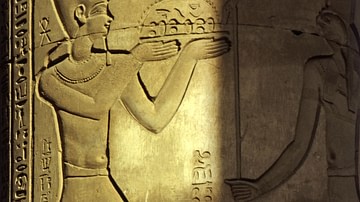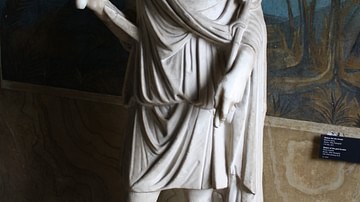Regarded by the Romans as “fatale monstrum”- a fatal omen, Cleopatra is one of the ancient world's most popular, though elusive figures. The Egyptian Queen has been immortalized by numerous writers and film-makers, most popularly by Shakespeare in Antony and Cleopatra, and by Hollywood in Cleopatra (1963) starring Elizabeth Taylor and Richard Burton. The latter work features the memorable image of the enticing young Cleopatra emerging gracefully from an unfurled carpet in front of Roman general Julius Caesar. But is Cleopatra to be regarded merely as the lover of Julius Caesar and Mark Antony? Or did she play an important role not only in the history of Egypt, but also in that of the mighty Roman Republic?
Cleopatra VII Philopator ('father-loving') was born in January 69 BCE in the city of Alexandria, Egypt, the daughter of Ptolemy XII Auletes (117 BCE –51 BCE) and possibly Cleopatra V Tryphaena (c. 95 BCE – c. 57 BCE). Cleopatra was to become the last monarch of the Ptolemaic Empire (established in 323 BCE after the death of Alexander the Great), ruling Egypt from 51 BCE to 30 BCE. In 48 BCE Cleopatra had become an ally and lover of Julius Caesar and remained so until his assassination in Rome in March of 44 BCE. The death of Caesar threw Rome into turmoil, with various factions competing for control, the most important of these being the armies of Mark Antony (83 BCE– 30 BCE) and Octavian (63 BCE – 14 CE), the former a supporter and loyal friend Caesar, the latter his adopted son.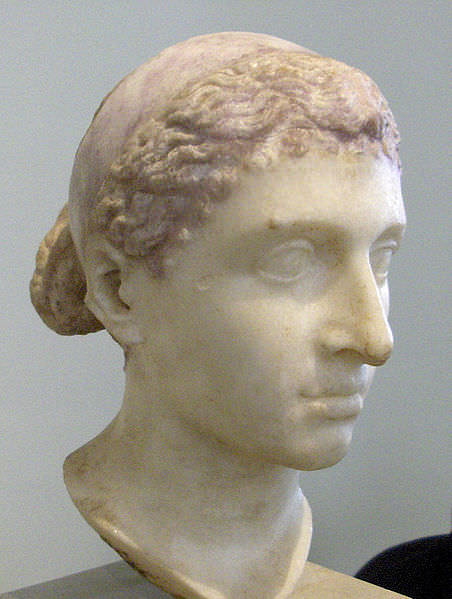
Cleopatra Meets Antony
In 41 BC Cleopatra was summoned to Tarsus (in modern southern Turkey) by Mark Antony. She is said to have entered the city by sailing up the Cydnus River in a decorated barge with purple sails, while dressed in the robes of the Greek goddess Aphrodite. Antony, who equated himself with the god Dionysus, the Greek god of wine, was instantly won over. Much like the meeting between Cleopatra and Caesar, both sides saw something in the other which they needed. For Cleopatra it was another opportunity to achieve power both in Egypt and in Rome, for Anthony the support of Rome's largest and wealthiest client states in his campaign against the might of the Parthians (Parthia was a region in modern north-eastern Iran) was highly desirable. At the meeting Cleopatra allegedly requested that her half-sister Arsinoë, living in protection at the Temple of Artemis at Ephesus, be executed to prevent any future attempts on her throne. Anthony and Cleopatra soon became allies and lovers and he returned with her to Alexandria in 40 BCE.
In Alexandria Cleopatra and Antony formed a society of “inimitable livers”, which some historians have interpreted as an excuse to lead a life of debauchery, though it was more likely to have been a group dedicated to the cult of the mystical god Dionysus. In that year Cleopatra bore Antony the twins Alexander Helios (the Sun) and Cleopatra Selene (the Moon).
Octavian & Rome
The political situation in Rome compelled Antony to return to Italy where he was forced to conclude a temporary settlement with Octavian, part of which was that he married Octavian's sister, Octavia. It was to be three years before he and Cleopatra were to meet again, at the city of Antioch (near the modern Turkey / Syria border) under the shadow of the Octavian's growing military power in the West. One result of this meeting was that Cleopatra became pregnant with her third child by Antony (the future Ptolemy Philadelphus); another was that parts of Rome's eastern possessions came under Cleopatra's control.
Celebrations in Alexandria
In 34 BCE, despite the fact that Antony's Parthian campaign had been an extravagant failure, Antony and Cleopatra celebrated a mock Roman Triumph in the streets of Alexandria. Crowds flocked to the Gymnasium to see the couple seated on golden thrones surrounded by their children, and Antony made a proclamation known today as the 'Donations of Alexandria'. In this declaration Antony distributed lands held by Rome and Parthia amongst Cleopatra and their children, and proclaimed Caesarion as Caesar's legitimate son. Not surprisingly, the 'Donations of Alexandria' caused outrage in Rome, where the rumour began to spread that Antony intended to transfer the empire's capital from Rome to Alexandria. In 32 BCE, Octavian had the Senate deprive Antony of his powers and declare war against Cleopatra, calling her a whore and a drunken Oriental. To avoid another civil war, Antony was not mentioned in the declaration, but this was to no avail and Antony decided to join the war on Cleopatra's side.
The Battle of Actium & the Invasion of Egypt
The culmination of the war came at the naval Battle of Actium, which took place near the town of Preveza in northwestern Greece, on September 2, 31 BCE. Here Mark Antony and Cleopatra's combined force of 230 vessels and 50,000 sailors were defeated by Octavian's navy commanded by Marcus Vipsanius Agrippa, effectively handing control of the Roman world over to Octavian. In 30 BCE Octavian invaded Egypt and laid siege to Alexandria. Hopelessly outnumbered, Anthony's forces surrendered and, in the honourable Roman tradition, Antony committed suicide by falling on his sword.
The Death of Cleopatra
After Antony's death Cleopatra's was taken to Octavian who informed her that she would be brought to Rome and paraded in the streets as part of his Triumph. Perhaps unable to bear the thought of this humiliation, on August 12, 30 BCE Cleopatra dressed in her royal robes and lay upon a golden couch with a diadem on her brow. According to tradition (found in ancient historian Plutarch, for example) she had an asp (an Egyptian cobra), brought to her concealed in a basket of figs, and died from the bite. Two of her female servants also died with her. The asp was a symbol of divine royalty to the Egyptians, so by allowing the asp to bite her, Cleopatra became immortal. Other historians (including Joyce Tyldesley) believe that Cleopatra used either a poisonous ointment or a vial of poison to commit suicide.
Cleopatra had lived thirty nine years, for twenty-two of which she had reigned as queen, and for fourteen she had been Antony's partner in his empire. After her death her son Caesarion was declared pharaoh, but he was soon executed on Octavian's orders. Her other children were sent to Rome to be raised by Antony's wife, Octavia. Cleopatra represented the last significant threat to Roman authority and her death also marks the end of the Ptolemaic Kingdom. The vast treasures of Egypt were plundered by Octavian, and Egypt itself became a new Roman province. Within a few years the Senate named Octavian Augustus and he became the first Roman Emperor, consolidating the western and eastern halves of the Republic into a Roman Empire.
Octavian later published his biography in which he stripped Cleopatra of her political ability and portrayed her as an immoral foreigner, a temptress of upright Roman men. A number of Roman historians and writers (the poets Horace and Lucan for example) reinforced the image of Cleopatra Empire an incestuous, adulterous whore who used sex to try and emasculate the Roman Empire. Unfortunately, such Roman propaganda has had a profound influence on the image of Cleopatra that has been passed down into Western culture. The real Cleopatra was highly skilled politically (though ruthless with her enemies), popular with her subjects, spoke seven languages, and was said to be the only Ptolemy to read and speak Egyptian. It is also a sobering thought to remember how different the history of western civilization might have been if Cleopatra had managed to create an eastern empire to rival the increasing might of Rome, which she very nearly succeeded in doing.
Recent archaeological work has cast some interesting but controversial light on the possible location of Cleopatra's tomb. Greco-Roman historian Plutarch wrote that that Antony and Cleopatra were buried together, and, in 2008 CE archaeologists from the Egyptian Supreme Council of Antiquities and from the Dominican Republic, working at the Temple of Taposiris Magna, 28 miles west of Alexandria, reported that one of the chambers in the building probably contained the bodies of Cleopatra and Mark Antony. The team have so far discovered 22 bronze coins inscribed with Cleopatra's name and bearing her image, a bust of Cleopatra, and an alabaster mask believed to represent Mark Antony. Work at the site is ongoing, and only time will tell if the archaeologist are correct in their theory that the great couple were interred at such a distance from Alexandria.
